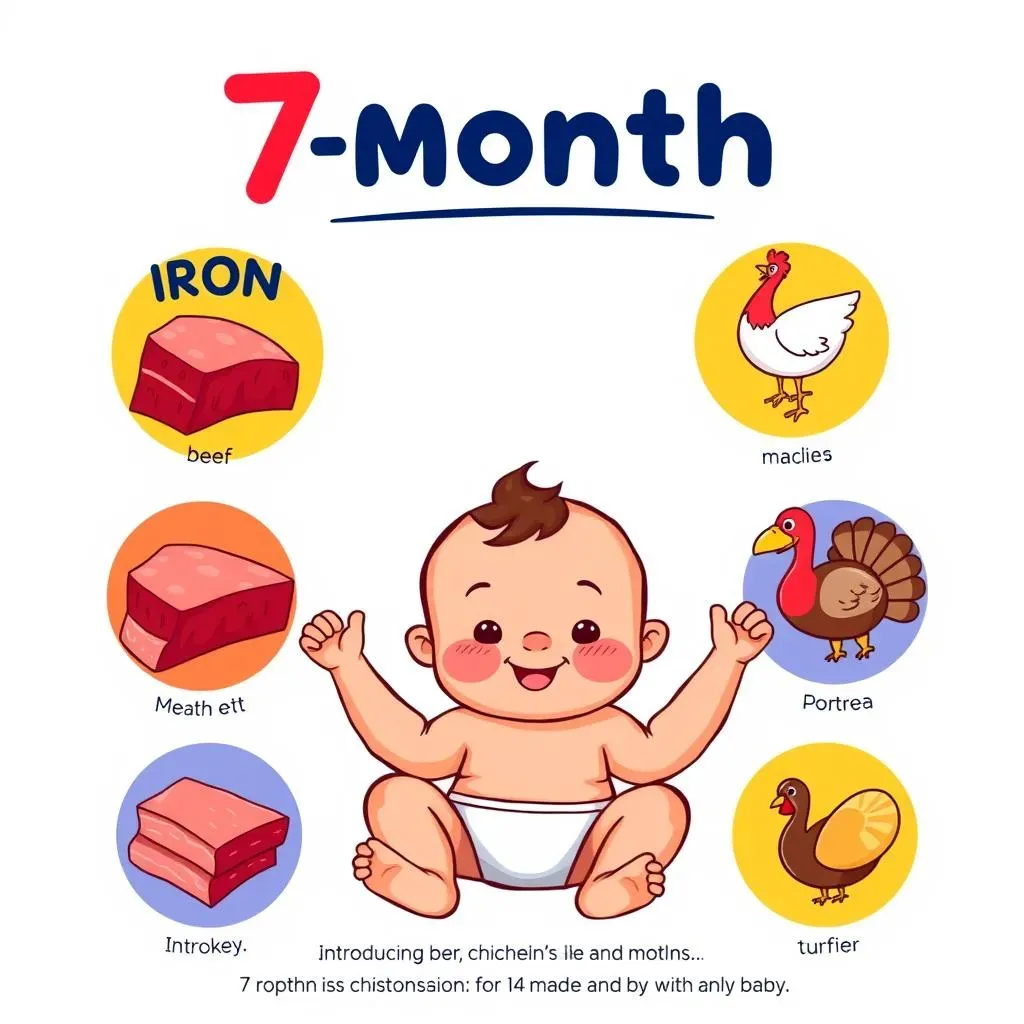Table of Contents
Introducing your little one to solid foods is a big milestone, and choosing the right foods is crucial for their healthy development. This article is your go-to guide for navigating the exciting world of "7 month old meat recipes." We'll explore the nutritional benefits of introducing meat at this age, dispelling common myths and anxieties parents often have. Get ready to discover a collection of simple, safe, and delicious meat recipes perfectly tailored for your 7-month-old's palate and developmental stage. We'll cover everything from the best types of meat to use to clever cooking techniques that ensure your baby enjoys their meals while minimizing choking hazards. Learn how to prepare nutritious purees, perfectly sized finger foods, and other creative ways to incorporate meat into your baby's diet. We'll also address potential concerns, such as allergies and constipation, providing practical solutions and expert advice to ease your worries. By the end, you'll feel confident and empowered to create healthy, enjoyable meals that fuel your baby's growth and development. Let's get started on this delicious adventure!
Why Introduce Meat at 7 Months?

Why Introduce Meat at 7 Months?
Iron Powerhouse
Around 7 months, your baby's iron stores from birth start to dwindle. Iron is super important for healthy blood and brain development. Meat is a fantastic source of heme iron, which is easier for little bodies to absorb than the non-heme iron found in plants. Think of it like this: heme iron is like a VIP pass, getting right into the cells, while non-heme iron has to wait in line. Giving your baby meat helps them get the iron they need to thrive.
Introducing iron-rich foods like beef, chicken, or turkey early can help prevent iron-deficiency anemia, a condition that can lead to fatigue, poor growth, and developmental delays. There are plenty of yummy options to explore; check out our recipe for beef meatballs for a fun and nutritious meal.
Protein Power-Up
Meat is packed with protein, the building block for your baby's growing muscles, organs, and tissues. Protein helps repair cells and keeps everything running smoothly. It's like the fuel for their amazing little bodies. Just as adults need protein for energy and muscle growth, babies require it too, and meat provides a high-quality source.
Different meats offer various amounts of protein and other nutrients. For instance, chicken is lean and easily digestible, while beef provides more iron. Experiment with different types of meat to find what your baby enjoys and to ensure a wide range of nutrients. Looking for a quick and easy option? Try our quick beef meatball recipe!
- Beef
- Chicken
- Turkey
Zinc Zing
Besides iron and protein, meat is also a good source of zinc, another essential nutrient for growth and development. Zinc helps support a healthy immune system, helping your baby fight off those pesky colds and illnesses. It's like adding an extra layer of protection for their little bodies.
Zinc is crucial for cell growth, wound healing, and even healthy skin. A deficiency can lead to various health issues, highlighting the importance of including zinc-rich foods in your baby's diet early on. To make sure your baby gets enough zinc, incorporate various meats into their diet. A great option is our recipe for best ground beef meatballs.
Nutrient | Benefits | Meat Sources |
|---|---|---|
Iron | Healthy blood, brain development | Beef, chicken, turkey |
Protein | Muscle growth, tissue repair | Beef, chicken, turkey, lamb |
Zinc | Immune system support, cell growth | Beef, chicken, turkey |
Safe and Simple 7 Month Old Meat Recipes

Safe and Simple 7 Month Old Meat Recipes
Pureed Perfection
Starting with purees is a great way to introduce meat. Think simple, single-ingredient purees like chicken or beef. Cook the meat until it's incredibly tender, then blend it until smooth. You can add a little breast milk or formula to help with the blending process. Remember, you want it super smooth to minimize any choking risk. For extra flavor, you can add a tiny pinch of herbs like dill or parsley, but always check with your pediatrician before introducing new flavors.
Once you've mastered the single-ingredient puree, you can start experimenting with combinations. Sweet potato and chicken is a classic combo, offering both sweetness and savory flavor. For a different take, try our beef meatball recipe pureed for a smooth, iron-rich option. Always introduce new foods one at a time, waiting a few days to check for any allergic reactions.
- Chicken Puree
- Beef Puree
- Turkey Puree
Meatball Magic
Meatballs are a fun and easy way to serve meat to your little one. Make small, bite-sized meatballs using ground chicken, turkey, or beef. Avoid adding salt or strong spices. You can steam, bake, or gently boil the meatballs until they're soft and easily mashed with a fork. The key here is to make sure they are soft enough for your baby to easily gum and swallow.
For a flavorful twist, you can add finely grated vegetables like carrots or zucchini to your meatball mixture. Serve the meatballs whole or cut them into smaller pieces, ensuring they are small enough to prevent choking. Looking for a recipe? Our easy ground beef meatball recipe is a great starting point. Remember to always supervise your baby while they are eating.
Meat Type | Cooking Method | Serving Suggestion |
|---|---|---|
Ground Chicken | Steaming | Whole or halved |
Ground Turkey | Baking | Pureed or quartered |
Ground Beef | Boiling | Mashed or finely chopped |
Finger Food Fun
As your baby gets a bit older (around 8-9 months), you can start offering small strips of cooked chicken or beef as finger foods. Choose very tender cuts, and cut the meat into long, thin strips that are easy for little hands to grasp. Make sure the strips are soft enough to gum, and always supervise your baby closely during mealtimes.
Chicken drumsticks (without skin) are also a great option. The bone provides a handle, making it easier for your baby to hold and self-feed. Remember, safety is paramount. Always remove any potential choking hazards like bones or skin before serving. For more ideas on serving meat, consider our best beef meatball recipe adapted for finger foods.
"Remember, introducing solids is a journey, not a race. Go slow, observe your baby, and celebrate the milestones along the way!" - Dr. Anya Sharma, Pediatrician
Tips for Preparing 7 Month Old Meat Recipes
Meat Selection and Sourcing
Choosing the right meat is crucial. Opt for lean cuts of chicken, turkey, or beef. Avoid fatty meats, as they're harder to digest and can upset your baby's tummy. Organic or pasture-raised options are great if your budget allows, as they tend to be lower in harmful chemicals. However, conventionally raised meats are perfectly safe too.
When buying meat, ensure it's fresh and hasn't passed its expiry date. Smell it; it should have a pleasant aroma, not a sour or unpleasant odor. If you have any doubts, err on the side of caution. For extra flavor and nutrition, consider adding finely diced vegetables like carrots, zucchini, or sweet potatoes to the meat while cooking. Check out our best ground beef guide for additional tips.
- Lean chicken breast
- Ground turkey
- Lean ground beef
Cooking Methods for Tiny Tummies
Steaming, boiling, or baking are the gentlest cooking methods for baby's first meats. Avoid frying, as it can add unhealthy fats. Steaming preserves nutrients and keeps the meat moist and tender. Boiling is also a good option, especially for purees, as it allows you to easily blend the meat afterward. Baking is great for meatballs or small pieces of meat.
Always ensure the meat is cooked thoroughly to an internal temperature of at least 165°F (74°C). This eliminates any potential bacteria that could harm your little one. Once cooked, let the meat cool completely before serving. Remember to always supervise your baby while eating and be prepared to cut the meat into smaller pieces if needed for easier handling.
Cooking Method | Advantages | Suitable for |
|---|---|---|
Steaming | Preserves nutrients, tenderizes meat | Purees, small pieces |
Boiling | Easy to blend, good for purees | Purees, broth |
Baking | Good for meatballs, retains moisture | Meatballs, small pieces |
Pureeing and Texture Tips
For purees, use an immersion blender for a smooth texture or a regular blender, adding a little breast milk or formula if needed to achieve the desired consistency. Start with very fine purees, gradually increasing the chunkiness as your baby gets older and develops their chewing skills. A simple masher can help create slightly chunkier textures.
For finger foods, cut the meat into small, manageable pieces that are easy for your baby to grasp and gum. Remember, the size of the pieces should be appropriate for your baby's developmental stage. Avoid anything that could pose a choking hazard. For more ideas, explore our Italian beef meatball recipe and adapt the size of the meatballs for your little one.
"Always remember to introduce new foods one at a time, observing your baby for any allergic reactions. Consult your pediatrician if you have any concerns." - Dr. Emily Carter, Registered Dietitian
Troubleshooting Common Concerns with 7 Month Old Meat Recipes

Troubleshooting Common Concerns with 7 Month Old Meat Recipes
Allergic Reactions
While meat allergies are less common than other food allergies, they can still occur. Always introduce new meats one at a time, starting with a tiny amount. Wait 2-3 days before introducing another new meat to observe for any allergic reactions. Common signs of an allergic reaction can include hives, rash, swelling, vomiting, or difficulty breathing. If you notice any of these symptoms, stop giving your baby the meat immediately and contact your pediatrician.
Keep a food diary to track what your baby eats and any reactions they might have. This will help you and your doctor identify potential allergens. If you suspect a meat allergy, your doctor may recommend allergy testing to confirm the diagnosis. For a delicious and safe alternative, check out our Italian-style meatball recipe, which uses leaner meats and avoids common allergens.
- Hives or rash
- Swelling of the face, lips, or tongue
- Vomiting or diarrhea
- Difficulty breathing
Constipation Concerns
Meat is relatively low in fiber, which can sometimes lead to constipation. To counter this, ensure your baby is getting enough fluids. Breast milk or formula is usually sufficient, but you can offer small amounts of water between feedings as well. Introduce high-fiber foods alongside meat, such as pureed sweet potatoes, carrots, or peas. These foods add bulk to your baby's stool, making it easier to pass.
If your baby seems constipated (infrequent bowel movements, hard stools, straining), talk to your pediatrician. They can help determine the cause and recommend appropriate solutions. In the meantime, try gently massaging your baby's tummy to help stimulate bowel movements. For a recipe that combines meat with fiber-rich veggies, try our beef meatball soup recipe, which offers a balanced and nutritious meal.
Symptom | Solution |
|---|---|
Infrequent bowel movements | Increase fluid intake, add fiber-rich foods |
Hard stools | Massage baby's tummy, offer prune puree |
Straining | Consult pediatrician |